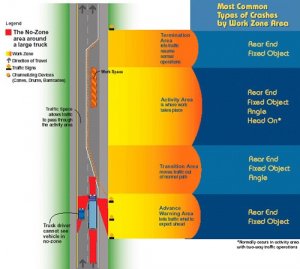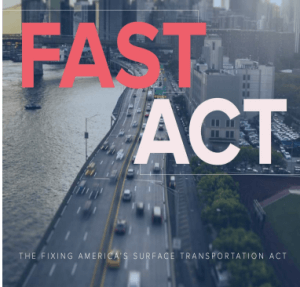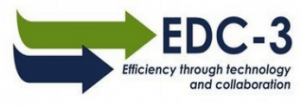In this Issue:
Promoting Safety in Work Zones: Best Practices for Large Trucks
FHWA Announces $60 Million in Grant Funding Towards ITS Under FAST Act
New Jersey Makes Progress in Implementing EDC-3 Initiatives
10% of US Bridges Deemed in a State of Deficiency
New Data Shows Traffic Fatalities Increasing on a National Scale
Did you know…
Director’s Message
The spring is upon us, and with it comes the promise of growth and change. As part of our own renewal here at the New Jersey Local Technical Assistance Program, we’re excited to launch our inaugural NJ LTAP printed newsletter. In this expanded issue, you will find information about innovations from around the country concerning work zone safety; read about transportation workforce development, and access the latest developments from our national partners in funding and research opportunities.
Even though we are broadening our communication efforts, our message remains the same. The entire NJ LTAP team is resolute in its mission to provide you with the best training, publications, and technical resources concerning public works, engineering, roadway construction, and law enforcement. Our training portfolio has been expanded to include more frequent offerings of some of our most popular courses, as well as some brand new options. As always, we continue to offer high quality training with experienced instructors that have become the hallmark of our program. In addition to our course offerings, NJ LTAP also offers a variety of technical assistance services to local agencies. More information, along with previous issues of our newsletter, can be found at https://test-ru-cait.pantheonsite.io/njltap.
Furthermore, for those of you in New Jersey and surrounding areas, we encourage you to join us on April 27th for our annual New Jersey Work Zone Safety Conference. Both seasoned veterans and new personnel alike will benefit from hearing about how to stay safe when on the job. Our agenda this year includes advancements in technologies and products, panel discussions with law enforcement, labor, and industry partners, and awards highlighting the efforts of individuals companies and roadway agencies who have excelled in the area of Work Zone Safety. You can register and find more information at the NJ LTAP website. We look forward to seeing you there!
First Responder Facts
According to the National Law Enforcement Officers Memorial, over the past 24 years, an average of twelve Police Officers have lost their lives in struck-by incidents each year. Approximately 5 Firefighters and 60 Tow Operators will also succumb to injuries suffered from struckby incidents. These alarming statistics are the impetus for Traffic Incident Management (TIM) training being provided to first responders throughout the country to raise their level of awareness and provide strategies to reduce the risk of being injured or killed.
Accordingly, in 2009 New Jersey adopted the Move Over Law which requires motorists to move over one lane upon observing stationary emergency vehicles, tow trucks and highway safety vehicles that display red, blue and/or amber flashing lights. If a motorist is unable to move to an adjacent lane away from the authorized vehicle, they must then slow down below the posted speed limit and be prepared to stop. The fine for this violation is not less than $100 or more than $500. If motorists and first responders alike exercise due caution at highway incidences, we can reduce the number of family members that have to be notified of the tragic loss of a loved one. Register for our Traffic Incident Management classes on the LTAP website at https://test-ru-cait.pantheonsite.io/cait/trafficincident-management
Help Design Our New Logo
The New Jersey Local Technical Assistance Program welcomes you to help us create our new logo! Between May 1st and July 1st we will be accepting logo designs and ideas from all applicants! The logo must contain the name (NJLTAP), either as an acronym or spelled out. Winners will be selected based on aesthetic quality, LTAP logos from across the country generally contain some imagery of the specific state and relevance to the overall mission of providing technical assistance in the field of transportation. The winner will be featured in the next newsletter, and on NJ LTAP materials for years to come! Send all entries to NewJerseyLTAP@gmail.com, and good luck!
SHRP2 Applications Open
The Implementation Assistance Program is available to help State departments of transportation (DOTs), metropolitan planning organizations (MPOs), and other interested organizations deploy SHRP2 Solutions. A range of opportunities is available to raise awareness of SHRP2 Solutions and to encourage early adoption of these products. There have been six implementation assistance offerings to date. Each product selected for implementation assistance has the potential to deliver more efficient, cost-effective programs to meet the complex challenges facing transportation today.
Round 7 At-A-Glance
Round 7 is the final full-scale or formal Implementation Assistance Program opportunity planned for SHRP2. The application period will open April 1 and close April 29, 2016. Nondestructive Testing for Tunnel Linings (R06G) Using nondestructive testing technologies to rapidly and comprehensively pinpoint defects in or behind tunnel linings. Reliability Data and Analysis Tools (L02/L05/L07/L08/ C11) A suite of tools to help transportation planners and engineers improve monitoring and analysis of data to achieve more consistent, predictable highway travel. Railroad-DOT Mitigation Strategies (R16) Innovative techniques that streamline processes, coordination, and partnering between transportation agencies and railroads. Nondestructive Testing for Concrete Bridge Decks Better, faster methods for determining concrete bridge deck conditions. Service Limit State Design for Bridges (R19B) A bridge design approach informed by qualitative data that adds years to service life
SHRP 2 Round 7 Techniques to Fingerprint Construction Materials (R06B) Materials verification without sampling delays Utility Bundle (R01A/R01B/ R15B) Techniques and resources for better managing utility conflicts in transportation projects. Advanced Methods to Identify Pavement Delamination (R06D) Nondestructive testing technologies that can detect delamination in hot-mix asphalt (HMA), operate at reasonable travel speed, and cover full lane width. Service Life Design for Bridges (R19A) Comprehensive guidance to select and design durable bridge systems and components that are both easier to inspect and better-suited to their environments. Plan Works: Better planning. Better projects. (C01) Systematic web-based resource that supports collaborative decision making to deliver projects that meet environmental, community, and mobility needs. Guidelines for the Preservation of High-Traffic Volume Roadways (R26) Your guide to the most affordable options for extending pavement life. Guidelines for Incorporating Reliability Performance Measures into Travel Models (L04) Guidelines for incorporating reliability performance measures into travel models.
Challenges and Opportunities: Women in Transportation
Opportunities for women in transportation range from blue collar jobs to jobs requiring a professional degree; even with this wide variety, women are significantly underrepresented in the field. According to the U.S. Department of Labor Women’s Bureau, women comprised 47 percent of the total U.S. labor force in 2010, and are projected to account for 51 percent by 2018. In transportation and material moving occupations, however, women make up only 15 percent of the workforce. Private firms and public agencies are identifying the issues that prevent women from working in transportation, and are planning to correct this imbalance.

Challenges and Opportunity
In 2011, the National Dialogue on Women in Blue Collar Transportation Careers identified barriers that women face in pursuing blue collar jobs in transportation. Among these barriers are several that clearly apply across the board.
- Women are not educated about opportunities in nontraditional occupations, and are not aware of the benefits and the challenges that these fields offer.
- The traditionally male dominated workplace is a difficult environment in which to work on a daily basis, and creates barriers to career advancement for women.
- Non-traditional fields lack role models for women, impeding efforts to draw women to the field.
- In recent years, traditionally male-dominated careers have attracted enough women that they are no longer considered non-traditional – a worthy goal for the transportation industry as well.
Strategies: Recruit, Retain, Mentor
As public agencies and private firms study the issue, several strategies emerge that should help women find careers in transportation. Conclusions based on research and practical experience point to the effectiveness of programs for recruiting, retaining, and mentoring women in the field.
Outreach can begin in the early grades, where presentations demonstrate that STEM (Science, Technology, Engineering, Mathematics) careers are gender neutral. In upper grades, recruitment programs help students uncover new interests and talents. The Women’s Transportation Seminar (WTS) and the U.S Department of Transportation sponsor the Transportation YOU program, which encourages girls between the ages of 13 and 18 to learn about careers in transportation. SHRP2 Applications Open The Implementation Assistance Program is available to help State departments of transportation (DOTs), metropolitan planning organizations (MPOs), and other interested organizations deploy SHRP2 Solutions. A range of opportunities is available to raise awareness of SHRP2 Solutions and to encourage early adoption of these products. There have been six implementation assistance offerings to date. Each product selected for implementation assistance has the potential to deliver more efficient, cost-effective programs to meet the complex challenges facing transportation today. Round 7 At-A-Glance Round 7 is the final full-scale or formal Implementation Assistance Program opportunity planned for SHRP2. The application period will open April 1 and close April 29, 2016. Nondestructive Testing for Tunnel Linings (R06G) Using nondestructive testing technologies to rapidly and comprehensively pinpoint defects in or behind tunnel linings. Reliability Data and Analysis Tools (L02/L05/L07/L08/ C11) A suite of tools to help transportation planners and engineers improve monitoring and analysis of data to achieve more consistent, predictable highway travel. Railroad-DOT Mitigation Strategies (R16) Innovative techniques that streamline processes, coordination, and partnering between transportation agencies and railroads. Nondestructive Testing for Concrete Bridge Decks Better, faster methods for determining concrete bridge deck conditions. Service Limit State Design for Bridges (R19B) A bridge design approach informed by qualitative data that adds years to service life. Summer internships give high school students experience in the working world, and educate them about career possibilities. Partnerships with colleges and universities, where women work in the transportation industry and pursue college degrees at the same time, provide a direct career path and offer valuable work experience that is appropriate in any field. Recruitment initiatives cannot afford to neglect the wide audience reached via social media: Facebook, YouTube, LinkedIn, and similar professional sites reach an audience that is most comfortable with, and that will respond to, communication and education in electronic form.
Even the most successful recruiting efforts cannot guarantee that women who begin working in the transportation industry will remain there over time. Women in transportation need clear and practical paths to advancement and, as in other industries, recognition and training are essential. As the baby boomer generation reaches retirement age, organizations need to identify potential leaders and train employees to assume new responsibilities. Distinct challenges exist in organizations that are traditionally male dominated, and traditional leaders can be reluctant to promote women into positions usually held by men
Corporations and public agencies need to acknowledge the fact that women, even in the 21st century, shoulder family obligations that can interfere with traditional workplace environments. Other industries have adapted successfully to these conditions, creating part time or shared jobs, and allowing telecommuting. A particularly innovative adaptation sets a range of hours during the day as “core hours,” where all employees are expected to be at the physical workplace, available for meetings and collaborative projects. During the surrounding hours, employees can start and end the work day early or late, leaving time to take care of family matters. In the Information Technology industry, flexible hours and the core hour concept are seen as benefits for men and women, and in many areas are so common that new employees have come to expect them.
When women constitute a small percentage of employees, mentoring provides significant support, education, and guidance. WTS and the American Public Transportation Association (APTA) sponsor successful mentoring programs. APTA’s Early Career Program provides one local and one out-of-state mentor for each professional participant. In addition, APTA conducts research on skill gaps in the private and public sectors in an effort to improve retention efforts.
Changes in technology have altered the transportation industry as they have in many industries. In the past, for example, jobs that required physical labor were traditionally done by men. In recent years, increasing mechanization and computerization have removed many of these physical barriers, giving women easier access to non-traditional jobs. New technologies have also created new opportunities in transportation, where men do not have an advantage: jobs in air traffic control, freight shipment tracking, computer-aided design, and transportation systems management are equally available to men and women. There is no doubt that advances in technology and interest in preserving the environment will continue, and that the transportation industry will respond with new initiatives. Coupled with the support of recruitment and retention programs, women should have increased opportunity to pursue careers in transportation, and should assume an important place in the industry at all levels.
Enter the 2016 Build-a-Better Mousetrap Competition
The Build a Better Mousetrap Competition is a nationwide search for innovative solutions to everyday problems. Each year LTAP/TTAP Centers from around the country hold contests in each of their states, seeking out the most ingenious solutions towards problems faced by local transportation officials every day. The possibilities are endless; whether it’s the invention of new tools or the modification of existing ones, any idea that increases safety reduces costs, and improves the efficiency of transportation will be considered. The centers then submit their state’s nominee to the national competition where an overall idea is crowned. Ideas are judged on cost savings, ingenuity, ease of transference, and effectiveness in dealing with challenges. You can submit your entry at the ltap.org website, or email LTAP@artba.org for more information. Good luck!
Promoting Safety in Work Zones: Best Practices for Large Trucks
As we prepare to kick off National Work Zone Awareness Week, we are reminded of the hazards posed by large trucks negotiating work zones, particularly in the coming construction season. While twelve percent of all highway fatalities involve large trucks, a staggering twenty-five percent of work zone motor vehicle fatalities involve them, resulting in hundreds of deaths annually and making this a hazard worth recognizing in a category all its own. Workers, truckers, and bystanders all have a role to play in making sure our nation’s work zones are as safe as possible. It’s not hard to deduce why trucks pose such a threat; their immense size creates prolonged stopping distances, hampers the ability of truckers to navigate narrowing roadways, and leads to reduced visibility for workers, other drivers, and pedestrians. Indeed, in the best of conditions a truck traveling at 65mph will still require a full seven seconds to complete its stop. This number can be even longer depending on inclement weather, road conditions, load size and type, and conditions of the trucks brakes and tires. “In 2013, large trucks and buses were involved in 186 work zone crashes that resulted in fatalities,” said Federal Motor Carrier Safety Administration Chief Counsel, Scott Darling. “Tragedies like these can be avoided by paying attention, slowing down, carefully obeying signs and the direction of flagmen, maintaining a safe distance between vehicles, avoiding distractions and always keeping safety the number one priority.”
 Truckers must make sure to pay special attention to work zone signs. Seeing the warnings on the approach are the first indication to expect slowing speeds or temporary stops. However, truckers must also be aware that a large number of work zone accidents may involve their vehicles indirectly. Often times the size of the trucks can obscure road signs and work zone equipment from other drivers. In these instances, turning on your flashers to warn the traffic behind you is strongly recommended. Furthermore, some motorists may attempt to race around a slowing truck. While a trucker can do little to curb the behavior of another driver, being cognizant of these types of behaviors can help save lives around your vehicle. However, sometimes the best option is to plan a route that allows you to avoid known work zones altogether. Large truck drivers should also use extra caution while merging, and attempt to get to the correct lane far in advance of the lane closure. The blind spots surrounding a truck make this situation particularly dangerous for both other drivers and themselves. Workers will only be able to do so much on their end. The first and best way to protect workers is for employers to ensure that personnel have the proper class of safety vest at all times in the work zone. Wearing high-visibility gear can grab the attention of automobiles and maintaining proper communication with other workers on the job can help keep everyone informed and alert. Ensuring signs are properly placed and vehicles are given enough distance to respond to altered traffic patterns are both vital to a safely functioning work zone. “When driving through work zones, be respectful of highway workers and their workplace by slowing down,” says FHWA Administrator Nadeau. “Following the rules of the roadway makes it easier to expect the unexpected.”
Truckers must make sure to pay special attention to work zone signs. Seeing the warnings on the approach are the first indication to expect slowing speeds or temporary stops. However, truckers must also be aware that a large number of work zone accidents may involve their vehicles indirectly. Often times the size of the trucks can obscure road signs and work zone equipment from other drivers. In these instances, turning on your flashers to warn the traffic behind you is strongly recommended. Furthermore, some motorists may attempt to race around a slowing truck. While a trucker can do little to curb the behavior of another driver, being cognizant of these types of behaviors can help save lives around your vehicle. However, sometimes the best option is to plan a route that allows you to avoid known work zones altogether. Large truck drivers should also use extra caution while merging, and attempt to get to the correct lane far in advance of the lane closure. The blind spots surrounding a truck make this situation particularly dangerous for both other drivers and themselves. Workers will only be able to do so much on their end. The first and best way to protect workers is for employers to ensure that personnel have the proper class of safety vest at all times in the work zone. Wearing high-visibility gear can grab the attention of automobiles and maintaining proper communication with other workers on the job can help keep everyone informed and alert. Ensuring signs are properly placed and vehicles are given enough distance to respond to altered traffic patterns are both vital to a safely functioning work zone. “When driving through work zones, be respectful of highway workers and their workplace by slowing down,” says FHWA Administrator Nadeau. “Following the rules of the roadway makes it easier to expect the unexpected.”
FHWA Announces 60 Million in Grant Funding Towards ITS Under FAST ACT
The Federal Highway Administration announced a call for grant proposals to fund innovative technologies aimed at improving transportation safety, system performance, and infrastructure efficiency. The new $60 million dollar program, Advanced Transportation and Congestion Management Technologies Deployment Program (ATCMTD), was established under the FAST Act, and invites state departments of transportation, local governments, transit agencies, metropolitan planning organizations and other eligible entities to apply for funding. These intelligent transportation technology solutions have the potential to mitigate and solve issues including the increasing challenges of congestion, safety and reducing the severity and frequency of crashes, and reducing transportation-related emissions. As a precursor to the ATCMD grant, the 2015 US Department of Transportation report, “Beyond Traffic 2045 Trends and Choices,” brought attention to the need for innovative solutions to the nation’s transportation system. According to “Beyond Traffic”, “leveraging technology and innovation in areas like autonomous cars, vehicle-to-infrastructure communication, big data and data analysis will be essential for the nation’s transportation system as the U.S. population swells by 70 million more people over the next three decades.” The “Beyond Traffic” plan extends the national transportation outlook to 2045, and looks to conceive a new way of understanding transportation needs and the future of transportation for the country. ITS America Senior Vice President for Government & External Affairs Paul Feenstra responded to the report saying that he believes the explosion of data and real-time information is creating opportunities for the public and private sectors to work in tandem to lay the groundwork for truly intelligent transportation system.
The ATCMD grant funding is directly aimed at addressing the issues raised in “Beyond Traffic” and calls for innovative ideas to transform transportation to meet the needs of a changing society through 2045. U.S. Transportation Secretary Anthony Foxx said of the ATCMD program, “This program will take technological innovation to a new level and help to make the entire transportation network more reliable for commuters, businesses, and freight shippers. An efficient transportation system is the foundation of a strong economy.”
For further information on the ATMCD program, the Notice of Funding Opportunity (NOFO) published on March 23, 2016 is available at www.fhwa.dot.gov/fastact/funding.cfm.
New Jersey Makes Progress in Implementing EDC-3 Initiatives
Every Day Counts (EDC) is the Federal Highway Administration’s (FHWA) initiative to work with transportation stakeholders to foster innovation through accelerated project delivery and benefits deployed broadly to road users. The EDC-3 is the third round of this initiative, focusing on 2015 and 2016, and promotes 11 different innovations and goals. These goals are deployed on a state-by-state basis, and allow for states to decide which work better for them and their road users, and implement those that will benefit them most.
As of December 2015, the Progress Report #2 for EDC-3 showed that New Jersey has made progress in the focus area initiatives which include: Data Driven Safety Analysis for Safety Management, Data Models and Tools used in Regional Modes of Cooperation, Road Diets (Roadway Reconfiguration), Technology Applications in Smarter Work Zones, and Ultra-High Performance Concrete Connections for Prefabricated Bridge Elements. The projects included under these initiatives help to both foster a culture of technological innovation, as well as promote safety and improve the roadway system in the State. The projects range in nature from data collection and collaborative research amongst stakeholder groups to ITS technology implementation and reconfigured roadway design and construction. More specifically, the Smarter Work Zones project involves the NJ DOT plan to evaluate a queue warning system on a 10-mile stretch of I-295 as it approaches the I-295/I-76 Route 42 Direct Connection project in Camden County, in order to use ITS technology to reduce the number and severity of rear-end crashes. The NJ DOT is likewise promoting the implementation of road diets to address high pedestrian crash rates across the state, and has identified two projects incorporating them, both of which will be funded under the state Highway State Improvement Program (HSIP). Finally, the NJ DOT has adopted the routine use of Ultra-High Performance Concrete Connections on closure pours, and most notably, for deck replacements on the Pulaski Skyway rehabilitation project and the Route 46 over Musconetcong River Bridge Project.
Overall, the EDC program has been critical in helping save money and time while finding and implementing opportunities that best fit the needs of each state highway programs. The EDC encourages continued innovation to promote efficiency, through technology and collaboration in highway project delivery, to better serve each state and the nation as a whole.

While being deemed structurally deficient does not mean a bridge is going to collapse, it does mean that there are significant issues that need to be examined and potentially remediated.
Source: USDOT
10% of US Bridges Deemed in a State of Deficiency
The American Road and Transportation Builders Association’s (ARTBA) annual analysis of state bridge data in the United States Department of Transportation 2015 “National Bridge Inventory” database reports that of approximately 610,000 bridges, the nation has 58,500 structurally deficient bridges. This number, while reporting 2,574 fewer structurally deficient bridges than 2014, still represents nearly 10% of all bridges.
ARTBA notes that the purpose of the report is meant to help educate the public and policymakers that they have structural deficiencies in need of repair. Bridge decks and their support structures are inspected regularly by state DOTs for signs of deterioration or need for remediation. Deeming a bridge deficient doesn’t necessarily mean that the bridge is falling down, but rather is rated on a scale from 0 to 9 – with nine representing “excellent” condition and anything rated four or below classifying “structurally deficient and in need of repair.” Many bridges have deteriorated with age, and it the report shows that of “the 250 most heavily traveled bridges that need repairs, 85% were built before 1970 with the creation of the interstate highway system.” Maintaining aging bridges is key to their survival, and requires a consistent stream of funding to complete the work.
Continued federal investment in repair and remediation is critical to this infrastructure, but with the USDOT estimating a $115 billion backlog in repairs for bridges rated structurally deficient or functionally obsolete, the current pace of investment would take 21 years to replace or upgrade all the deficient bridges.
The five states with the most deficient bridges were Iowa with 5,025, Pennsylvania with 4,783, Oklahoma with 3,776, Missouri with 3,222 and Nebraska with 2,474. Some of the most heavily travelled and notable bridges deemed structurally deficient include, the Brooklyn Bridge in New York, the Memorial bridge in Washington, D.C., as well as several Interstate 95 bridges in Pennsylvania and Maryland and several Interstate 405 bridges in Los Angeles.
In light of the nation’s bridges in need of the repair, the USDOT Fostering Advancements in Shipping and Transportation for Long-term Achievement of National Efficiencies (FASTLANE) grants is good news for infrastructure investment. This program was established by the FAST Act and authorizes $800 million to fund what DOT determines are critical freight and highway projects. FASTLANE establishes broad, multi-year eligibilities for freight infrastructure, including intermodal projects – a first in the DOT’s 50 year history. Similarly, the USDOT began to give guidance to states on how to repurpose prior unused funds under the new Consolidated Appropriations Act 2016. This act allows states to use long-dormant earmarked funds to be redesignated for new, closed, or over 10 year old transportation projects by 2019. To be eligible, any new projects must be within 50 miles of the originally earmarked projects. The USDOT noted that this act has opened up more money for the FASTLANE grant program, as well as increased spending on University Transportation Centers and a new round of TIGER grants.
New Data Shows Traffic Fatalities Increasing on a National Scale
The latest estimate of traffic deaths reported in 2015 show that traffic deaths are increasing on a national scale. Recent data from The National Highway and Traffic Safety Administration (NHTSA) reports that the number of motor-vehicle deaths in 2015 totaled 38,300, up 8% from 2014. The data was derived from the NHTSA Fatality Analysis Reporting System, FastFARS, and Monthly Fatality Counts; and from the Federal Highway Administration’s (FHWA) vehicle miles traveled estimates.
The National Safety Council (NSC) gave some context to the increase in fatalities, noting that “continued lower gasoline prices – 28 percent lower in 2015 than in 2014 – and an improving economy have resulted in an estimated 3.5% increase in motor vehicle mileage – vehicle miles traveled increased in first nine months of 2015 by 80.2 billion miles,” which could be a factor in the increase. This past year’s spike has been a bit of a shock in comparison to recent years, where from 2000 to 2014, the number of fatalities had steadily declined over 22 percent. The NSC said the states with the largest increases in auto accident fatalities in 2015 were Oregon with 27 percent, Georgia with 22 percent, and Florida with 18 percent. Only 13 states had reductions in the number of car crash deaths last year – New Mexico with 20 percent, Kansas with 7 percent, and New Jersey with 2 percent showing the biggest declines.
Deborah A.P. Hersman, president and CEO of the safety council and former chairwoman of the National Transportation Safety Board said that the spike is the first in 50 years, and likewise points at the recovering economy as part of the cause in increased deaths. Hersman explains that, “During recession periods, people don’t drive to work as much or take as many vacations, since they have less discretionary income and fatalities usually fall.” As the economy continues to recover and improve and gas prices are projected to decline even more, Hersman encourages people to improve their defensive driving skills and not be so relaxed about engaging in risky driving, because “we’re killing each other.” To many, the numbers are a more concerning reminder that, even considering an increase in vehicle miles travelled, unsafe behaviors – such as drunk, drugged, distracted and drowsy driving; speeding; failure to use safety features such as seat belts and child seats – are still contributing greatly to road deaths. Past NSC research has indicated that alcohol, speed and distracted driving are the three major causes of fatalities on the road, contributing to 30.8, 30 and 26 percent of motor-vehicle deaths respectively. Human behavior and risky choices are an important factor when considering that although drivers log more total miles on urban roads and freeways, nearly half the increase in traffic deaths occurred on rural roads. Hersman noted that “rural roads are the deadliest roads that people drive on,” and that unlit, curvy roads are more difficult to drive and can become especially dangerous when drivers are drowsy or impaired. In spite of decades of vehicle design improvements and traffic safety advancements, driving a car is a still a risky endeavor and one that should not be taken for granted – something Hersman thinks Americans aren’t taking seriously.
U.S. Transportation Secretary Anthony Foxx responded to the NSC report saying that, “For decades, U.S. Department of Transportation has been driving safety improvements on our roads, and those efforts have resulted in a steady decline in highway deaths, but the apparent increase in 2015 is a signal that we need to do more.”
While Deborah Hersman is critical of Americans’ driving habits, she does see a brighter future in traffic safety with new vehicle design improvements being unveiled in recent years. She says, “While drivers still may be pretty consistent with their bad habits… the real key is what’s going on with the car. At the auto shows this year, you are seeing adaptive cruise control and lane departure warning and auto-braking systems.” She notes that these models can become pricey since they are new, but that the features should trickle into affordable models over time. Hersman sees these technologies as precursors to ultimately having autonomous vehicles on the roads, but are nevertheless ways to decrease driving errors and to improve road safety.
Did you Know…
New Jersey is a Towards Zero Deaths State. With the help of our federal and state transportation agencies, New Jersey is committed to the vision of eliminating fatalities and serious injuries on our roadways. TZD uses a data-driven, interdisciplinary approach that has been promoted by the Federal Highway administration for many years. By integrating the 4E’s (Education, Enforcement, Engineering, and Emergency Services) as a cohesive part of the Strategic Highway Safety Plan (SHSP), we hope to make that vision a reality. TZD is based on the principle that every single traffic death is unacceptable based on the tools we have to prevent them. As New Jersey’s official safety vision, TZD guides all of the traffic safety initiatives in the state. “We embrace the vision of Toward Zero Deaths; it provides an overarching and common vision that drives and focuses our efforts to achieve our shared goal to eliminate injuries and fatalities on our roadways,” said U.S. Transportation Secretary Anthony Foxx. “The U.S. Department of Transportation will do our part by aggressively using all tools at our disposal – research into new safety systems and technologies, campaigns to educate the public, investments in infrastructure and collaboration with all of our government partners to support strong laws and data-driven approaches to improve safety.”









